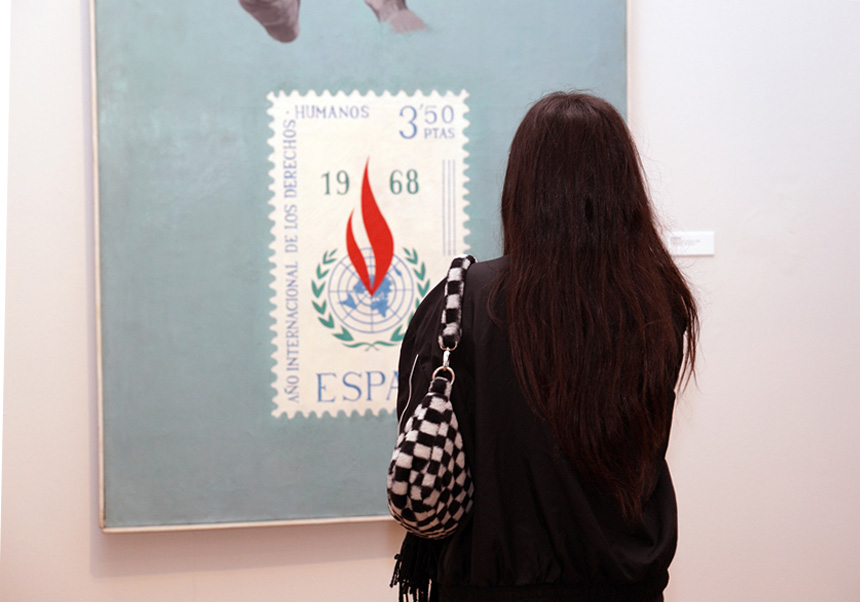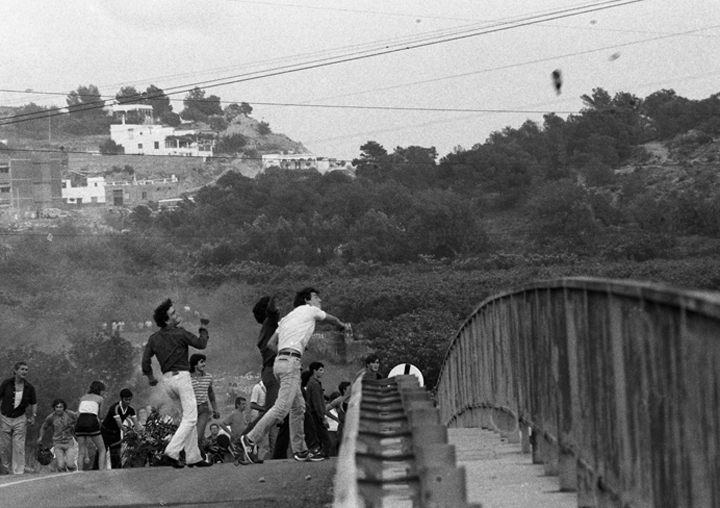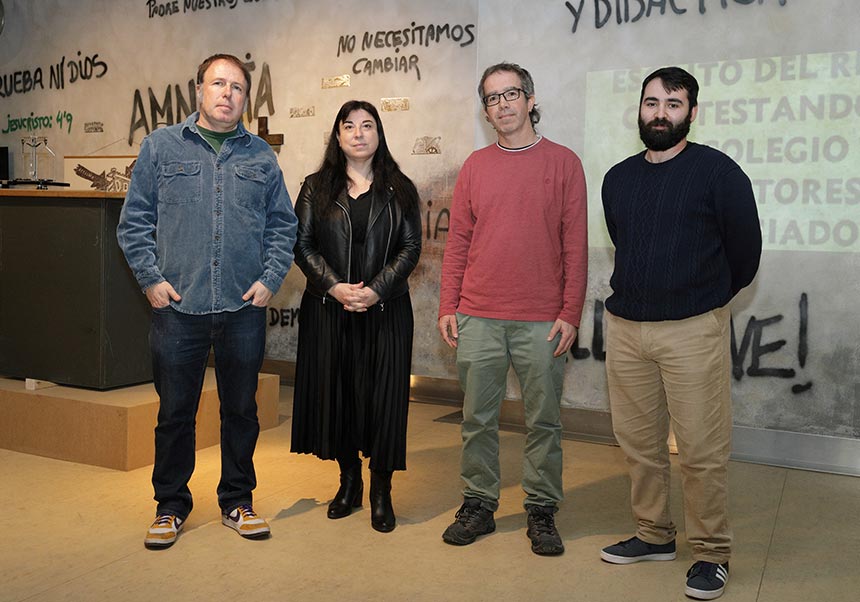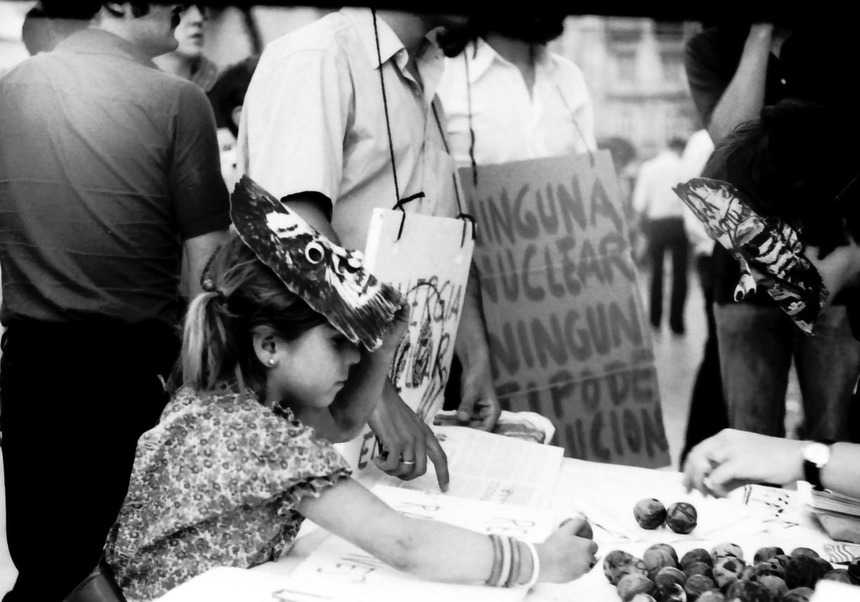The Martínez Guerricabeitia Collection of the UV revisits critical art beyond the politics of the ‘70s at La Nau
- UV General Foundation
- March 1st, 2024

On Thursday, 29 February, the Universitat de València opened the exhibition ‘FREEDOM, FREEDOM. The decade of the 70s in the Martínez Guerricabeitia Collection: politics and beyond’ at the Martínez Guerricabeitia room of La Nau Cultural Centre. Valencia becomes the second city to host this valuable exhibition project, which began last year in Castellón.
A total of 57 works (35 graphic works and 22 unique works) can be seen at La Nau by ten of the artists who make up the contemporary art collection put together by the married couple Jesús Martínez Guerricabeitia and Carmen García Merchante. They donated the collection to the Universitat de València in 1999, in a particularly noteworthy gesture of patronage.
After its massive success in Castellón, the exhibition opened in the former headquarters of the Universitat, in the presence of the vice-principal for Culture and Society of the UV, Ester Alba; the former director of the Martínez Guerricabeitia Collection and patron of the UV’s General Foundation, José Pedro Martínez; the director of activities of the Collection, José Martín; and the curator Juan Manuel Bonet. The selection arranged by the curator of the exhibition, Juan Manuel Bonet, brings the public closer to a decade that saw the assassination of Carrero Blanco, the dictator’s death, the return of the exiles and the first free elections.
According to its curator, the exhibition is a tribute to the couple, with whom he has been linked since 1994, when he was a member of the jury of the Martínez Guerricabeitia Biennial. “I was able to see their work and that of their team in favour of contemporary art. Our relationship became closer the following year, when I was appointed director of IVAM. They visited me periodically, told me about the exhibitions that had interested them and reaffirmed their commitment as patrons of the museum", Bonet recounted.
Jesús Martínez Guerricabeitia was a son of his generation. With a childhood and youth marked by the war and Franco's repression, prison —to which his convictions led him— turned him into a curious pupil, with a great deal of intellectual restlessness.
By reinventing himself as a young entrepreneur, a proof-reader and linotypist, and after a period spent abroad with his family, he was able to indulge his long-standing love of art by acquiring a few paintings on his return to Valencia in 1970.
This way, and thanks to their wide network of political, artistic and literary friendships, the couple began creating a collection that, inevitably, acquired a political aspect through emerging paintings of the late Franco years and the beginning of the Transition.
“The main value of their collection, now at the Universitat de València, is that it is not ‘cloned’ —as there are so many—, but is constructed from their personal vision and their interest in art of a political nature, which makes perfect sense, given the condition of the husband as a political prisoner and later a very active travelling companion of the PCE (Communist Party of Spain)”, says the curator of the exhibition.
The exhibition is based on the majority representation of Valencian artists, “in a context in which Valencia became the Spanish capital of certain compromising art, during the final years of Franco’s regime”. Thus, the list of leading artists includes the Valencian group Estampa Popular, from which ‘Crónica de la Realidad’ emerged. The teams ‘Crónica y Realidad’, ‘Genovés’ (working in Madrid), ‘Anzo’, and Antoni Miró participate in the group. The trio of Boix, Heras and Armengol and the members of the ‘Grup d’Elx’ also stand out. "All of them cultivate, to a greater or lesser degree, political pop. This is the moment when Josep Renau, exiled first in Mexico and then in Berlin, reencounters his homeland". In the graphic section, it is worth noting the presence of silkscreen prints by artists such as those mentioned above and by abstractionists such as Arcadio Blasco, Michavila, Teixidor and Yturralde. Many of them were made for folders intended to finance political parties, such as the PSOE, the PSP (Popular Socialist Party) and the PCPV (Communist Party of the Valencian Country).
The historical overview of this turbulent decade is rounded off by the works of a selection of national and international artists who complete the general artistic and political panorama of the period. "Also represented are the dark Fernando Somoza, Juan Barjola, José Luis Verdes, Gastón Orellana, José Ortega (founder of Estampa Popular), José Duarte, the Canogar of the years when he practised ‘Crónica de la Realidad’, Eduardo Arroyo (then in exile in Paris), Julián Pacheco (from Italy)...". On the international scene, the Italian Spadari and the Icelandic Erró are part of the same political pop scene, while Wolf Vostell alone represents the Fluxus aesthetic. On the graphic side, alongside Estampa Popular engravers such as Ibarrola and Francisco Cuadrado, there are international names (Lindner, Lichtenstein, Aldo Mondino and Lucio del Pezzo), and again abstract artists (Hernández Pijuán, Ràfols Casamada, Saura, Tàpies, Salvador Victoria...) whose political commitment led them to collaborate with folders supporting similar parties.
The exhibition can be visited until 8 September in the Martínez Guerricabeitia room of the La Nau Cultural Centre, from Tuesday to Saturday, from 10:00 to 14:00 and from 16:00 to 20:00, and Sundays and public holidays from 10:00 to 14:00. It was organised by the Office of the Vice-Principal for Culture and Society of the Universitat de València, the Martínez Guerricabeitia Collection and the General Foundation of the UV, in collaboration with UVsocietat, Caixa Popular and the Valencia City Council.
More information:
File in: Cultura , Exposicions , Altres espais expositius , Col·leccions , Fundació General UV
















